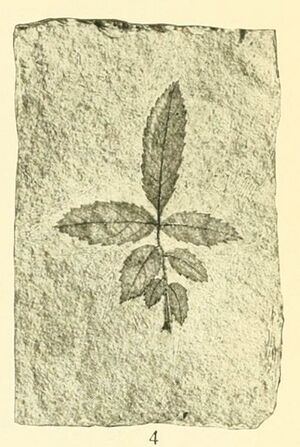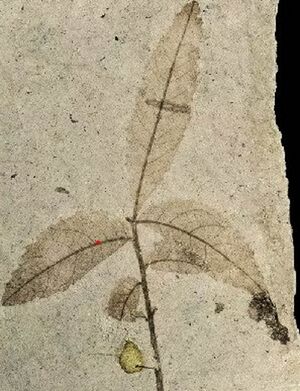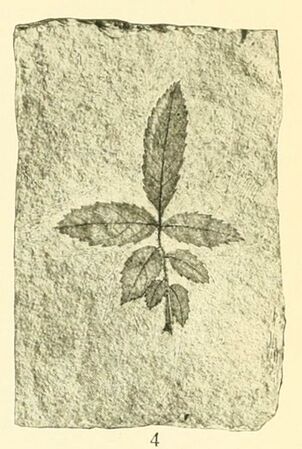Rosa scudderi Knowlt.
Fossile-Rose, 1917 - beschrieben vom Paläobotaniker/ described by the palaeobotanist/ décrit par le paléobotaniste Frank Hall Knowlton, USA
Eltern/ parentage/ parents: Botanische Rose/ Wild Rose/ Rosier botanique
Vermutliche Synonyme/ Presumed synonyms/ synonymes présumés: Rosa hilliae Lesq., Rosa dubia C.O.Weber
Die Synonyme wurden beschrieben von den Botanikern/ The synonyms were described by the botanists/ Les synonymes ont été décrits par les botanistes Daniel Isaac Axelrod, USA, Shigeru Miki, Japan, Hermann Engelhardt, Deutschland, Charles Arthur Hollick, USA, Ralph Works Chaney, USA, Frank Hall Knowlton, USA, Gábor (Gabriel) Andreánszky, Ungarn, Oswald von Heer, Schweiz, Theodore Dru Alison Cockerell, USA, Hsen Hsu Hu, China, Toshimasa Tanai, Japan, Wladyslaw Szafer, Polen
Allgemeines • Preface • Remarques
Benannt hat Frank Hall Knowlton diese Rose nach Samuel Hubbard Scudder (* 13.04.1837 in Boston, † 17.05.911 in Boston)[1]. Er war ein US-amerikanischer Entomologe und Paläontologe, mit Schwerpunkt fossile Insekten. Er entdeckte aber auch zahlreiche fossile Pflanzen.
Neben den zumeist gefundenen Fiederblättchen, wurde hier ein komplettes 7-fiedriges, fossiles Blatt einer Rose aus dem Oligozän[2] gefunden. Es ist somit zwischen 23,03 und 33,9 Millionen Jahre alt.
Frank Hall Knowlton named this rose after Samuel Hubbard Scudder (* 13.04.1837 in Boston, † 17.05.911 in Boston)[1]. He was an American entomologist and palaeontologist, specialising in fossil insects. However, he also discovered numerous fossil plants.
In addition to the mostly found leaflets, a complete 7-fingered fossilised leaflet of a rose from the Oligocene[2] was found here. It is therefore between 23.03 and 33.9 million years old.
Frank Hall Knowlton a donné à cette rose le nom de Samuel Hubbard Scudder (* 13.04.1837 à Boston, † 17.05.911 à Boston)[1]. Il était un entomologiste et paléontologue américain, spécialisé dans les insectes fossiles. Il a cependant également découvert de nombreuses plantes fossiles.
Outre les pinnules trouvées la plupart du temps, une feuille fossile complète de 7 pinnules d'une rose de l'Oligocène[2] a été trouvée ici. Elle est donc âgée de 23,03 à 33,9 millions d'années.
Originale Beschreibung • Original description • Description originale
Übersetzung:
ROSA SCUDDERI, neue Art.
Tafel 22, Fig. 4.
Blätter klein, mit sieben Fiederblättchen, das endständige (ungerade) Fiederblättchen schmal elliptisch, an Basis und Spitze gleichmäßig verschmälert, kurz gestielt, Länge 20 mm, Breite 6 mm; oberes Paar Fiederblättchen oval, sitzend, 12 mm und 15 mm lang und 4 bzw. 6 mm breit; mittleres Paar Fiederblättchen viel kleiner, etwa 8 mm lang und 3 oder 4 mm breit; unterstes Paar Fiederblättchen winzig, 5 oder 6 mm lang, etwa 2 mm breit; alle Fiederblättchen an der Basis ganz, dann grob gezähnt; Nervatur undeutlich mit anscheinend etwa 5 oder 6 Paaren von Nebenblättern; Nebenblätter undeutlich, anscheinend winzig und schmal.
Type.— C&t. No. 34,765, U.S.N.M.
ROSA SCUDDERI, new species.
Plate 22, fig. 4.
Leaves of small size, with seven leaflets, the terminal (odd) leaflet narrowly elliptical, equally narrowed to both base and apex, short petioled, length 20 mm., width 6 mm.; upper pair of leaflets oval, sessile, 12 mm. and 15 mm. long and 4 and 6 mm. wide respectively; middle pair of leaflets much smaller, about 8 mm. long and 3 or 4 mm. wide; lowest pair of leaflets minute, 5 or 6 mm. long, about 2 mm. wide; all leaflets entire at base, then coarsely toothed; nervation obscure with apparently about 5 or 6 pairs of secondaries; stipules obscure, apparently minute and narrow.
Type.— C&t. No. 34,765, U.S.N.M.
Traduction:
ROSA SCUDDERI, nouvelle espèce.
Planche 22, Fig. 4.
Feuilles de petite taille, à sept folioles, la foliole terminale (impaire) étroitement elliptique, également rétrécie à la base et au sommet, à pétiole court, d'une longueur de 20 mm, largeur 6 mm ; paire supérieure de folioles ovales, sessiles, 12 mm et 15 mm de long et 4 et 6 mm de large respectivement ; paire moyenne de folioles beaucoup plus petites, environ 8 mm de long et 3 ou 4 mm de large ; paire inférieure de folioles minuscules, 5 ou 6 mm de long, environ 2 mm de large ; toutes les folioles sont entières à la base, puis grossièrement dentées ; nervation obscure avec apparemment environ 5 ou 6 paires de secondaires ; stipules obscures, apparemment minuscules et étroites.
Type.— C&t. No. 34,765, U.S.N.M.
Fundort • Find location • Lieu de découverte
Das Rosenblatt wurde in den Florissant Fossil Beds[3] in Teller County, Colorado, USA gefunden.
The rose petal was found in the Florissant Fossil Beds[3] in Teller County, Colorado, USA.
Le pétale du rosier a été trouvé dans les Florissant Fossil Beds[3] dans le comté de Teller, Colorado, États-Unis.
- Rosa scudderi
Zum Vergrößern anklicken • click to enlarge • cliquez pour agrandir
↑ Nach oben • Top • Vers le haut ↑
Einzelnachweis • Footnotes • Notes
Weblinks • External links • Liens externes
Literatur • Literature • Littérature
- Proceedings of the United States National Museum, Vol. 51, 1917 Seite 272 - Text u. Pl. 22, Fig. 4 - Bild
- W. Jongmans, Fossilium Catalogus Part25, 1942 Seite 170
- Herman F. Becker, The fossil record of the genus Rosa, 1963 Rosa scudderi


